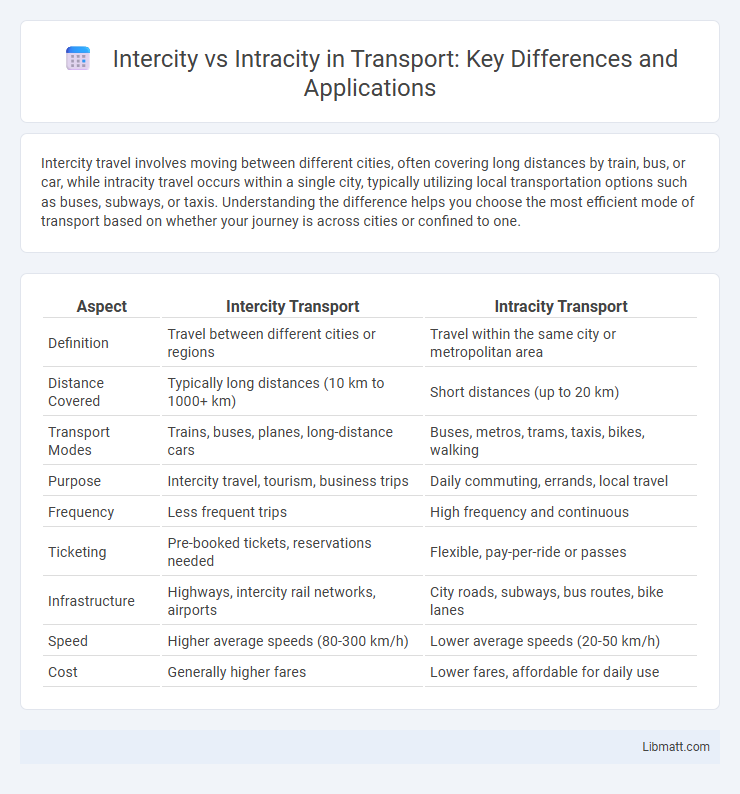Intercity travel involves moving between different cities, often covering long distances by train, bus, or car, while intracity travel occurs within a single city, typically utilizing local transportation options such as buses, subways, or taxis. Understanding the difference helps you choose the most efficient mode of transport based on whether your journey is across cities or confined to one.
Table of Comparison
| Aspect | Intercity Transport | Intracity Transport |
|---|---|---|
| Definition | Travel between different cities or regions | Travel within the same city or metropolitan area |
| Distance Covered | Typically long distances (10 km to 1000+ km) | Short distances (up to 20 km) |
| Transport Modes | Trains, buses, planes, long-distance cars | Buses, metros, trams, taxis, bikes, walking |
| Purpose | Intercity travel, tourism, business trips | Daily commuting, errands, local travel |
| Frequency | Less frequent trips | High frequency and continuous |
| Ticketing | Pre-booked tickets, reservations needed | Flexible, pay-per-ride or passes |
| Infrastructure | Highways, intercity rail networks, airports | City roads, subways, bus routes, bike lanes |
| Speed | Higher average speeds (80-300 km/h) | Lower average speeds (20-50 km/h) |
| Cost | Generally higher fares | Lower fares, affordable for daily use |
Understanding Intercity vs Intracity: Key Definitions
Intercity travel refers to transportation between different cities, often covering long distances via trains, buses, or flights, while intracity travel involves movement within the same city using local buses, subways, taxis, or ride-sharing services. Understanding these distinctions helps optimize Your travel plans by selecting the appropriate mode of transport according to distance and infrastructure. Key definitions clarify that intercity emphasizes regional connectivity, whereas intracity focuses on urban mobility and accessibility.
Geographic Scope: City Boundaries and Beyond
Intercity transport connects multiple cities, covering vast geographic areas beyond city boundaries, enabling regional, state, or national travel. Intracity transport operates within a single city's limits, facilitating mobility across neighborhoods and local districts. Your choice between intercity and intracity options depends on whether your journey spans city boundaries or remains within a confined urban area.
Transportation Modes: Comparing Options
Intercity transportation primarily relies on modes such as trains, buses, and airplanes designed for longer distances, offering higher speeds and more comfort for travelers. Intracity transportation focuses on options like buses, trams, subways, taxis, and bicycles, optimized for short distances and frequent stops within urban areas. The choice between intercity and intracity transportation modes depends on factors like travel distance, time efficiency, cost, and accessibility.
Travel Time and Distance Considerations
Intercity travel typically involves longer distances often exceeding 100 kilometers, resulting in extended travel times that can range from several hours to an entire day depending on the mode of transportation. In contrast, intracity travel covers shorter distances usually within a single metropolitan area, generally under 50 kilometers, with travel times averaging between 10 minutes to an hour due to urban traffic conditions and public transit options. Efficient route planning and the choice between highway travel for intercity trips or local roads for intracity journeys significantly impact overall travel time and distance optimization.
Cost Factors: Budgeting for Intercity vs Intracity Travel
Intercity travel typically incurs higher costs due to longer distances, increased fuel consumption, and possible tolls, whereas intracity travel expenses are generally lower with shorter routes and frequent public transportation options. Budgeting for intercity trips should account for accommodation, meals, and transportation combining various modes such as buses, trains, or flights. Intracity travel budgeting focuses mainly on daily commuting expenses including local transit fares, ride-sharing services, and fuel for personal vehicles.
Infrastructure Requirements and Challenges
Intercity transportation demands extensive infrastructure such as highways, railways, and airports designed for long-distance, high-speed travel, requiring significant investment and maintenance to manage traffic volume and safety. Intracity transport relies on dense networks of roads, public transit systems like buses and subways, and pedestrian pathways, posing challenges in congestion management, urban space limitations, and frequent stop-and-go operations. Your planning must address these diverse requirements to optimize efficiency and sustainability in either context.
Environmental Impact and Sustainability
Intercity transportation typically results in higher greenhouse gas emissions per trip due to longer distances and increased energy consumption, while intracity travel often relies on more sustainable modes like cycling, walking, and electric public transit. Urban areas investing in intracity electric buses and light rail systems can significantly reduce air pollution and carbon footprints compared to conventional intercity diesel vehicles. Prioritizing sustainable intracity transit infrastructure fosters reduced traffic congestion and promotes cleaner urban environments, which are critical for achieving long-term environmental goals.
Popular Use Cases and Daily Scenarios
Intercity transportation is commonly utilized for long-distance travel between major cities, such as commuting for business meetings, attending conferences, or visiting family across regions. Intracity transport primarily serves daily scenarios like commuting to work, school, or grocery shopping within urban areas, supporting activities like public transit rides, taxi services, and bike-sharing systems. Popular use cases for intercity travel include high-speed trains and intercity buses, while intracity relies heavily on subways and local buses to manage dense urban mobility efficiently.
Future Trends in Urban and Regional Mobility
Future trends in urban and regional mobility emphasize the integration of intercity and intracity transport systems through smart infrastructure and real-time data analytics. Electric and autonomous vehicles are expected to dominate both intercity highways and intracity streets, reducing emissions and improving efficiency. Seamless multimodal connectivity and demand-responsive transit solutions will reshape how people navigate urban centers and regional corridors, promoting sustainable growth and accessibility.
Choosing the Right Option: Factors to Consider
When choosing between intercity and intracity travel, consider factors such as distance, time, and convenience to match your specific needs. Intercity travel is ideal for longer distances connecting different cities, while intracity options best serve short trips within a single urban area. Your decision should also account for cost, available transportation modes, and the frequency of travel to optimize efficiency and comfort.
intercity vs intracity Infographic

 libmatt.com
libmatt.com